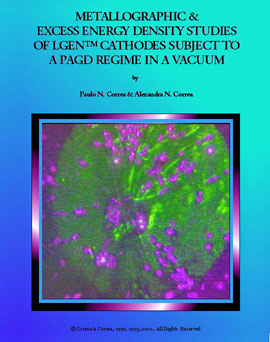![Akronos logo]](/images/akronos_wheel.jpg)
|
Akronos Publishing Concord, ON, Canada www.aetherometry.com |
![Akronos logo]](/images/akronos_wheel.jpg)
|
Akronos Publishing Concord, ON, Canada www.aetherometry.com |

Metallographic and excess energy density studies
of different LGENTM cathodes
subject to a PAGD regime in vacuum
by Correa, Paulo N. & Correa, Alexandra N.
Published in July 2001. 33 pages.
Series: Labofex Reports on Pulsed Plasmas
Monograph LS1-07
VIEW FULL TEXT: PDF
|
ABSTRACT
Supplementing the material detailed in Labofex's Scientific Reports LS1-02, LS1-06, and the PCT/CA93/00311 Application regarding the design of PAGD generators (LGENTM reactors), this Scientific Report addresses the PAGD current densities at the electrodes, in the cathode PAGD plasma ball and at the emission foci. Determination of the latter two parameters required both videographic and metallographic analyses, performed utilizing diverse types of cathode metals. PAGD cathode affinity was found to correlate with the electronegativity and work-function of the metal employed, PAGD affinity increasing with decreasing work-function. Anode surface distortions were equally examined. Utilizing this data together with determinations of the pulse input energy and the energy associated with the anomalous cathode reaction forces (proportional to 103 to 104 i2) observed in the LGENTM reactors during operation in the PAGD regime, we ascertained the fuel (cathode metal) consumption per PAGD, as well as the energy density of the fuel employed and expected cathode lifetimes. On the basis of the results herein presented, the PAGD regime can be regarded to be an autogenous pulsatory plasma discharge regime characterized by the presence of quasi-periodic, self-generating and self-extinguishing autoelectronic cold cathode emissions that segment an abnormal plasma glow, and do so at low values of the breakdown field and at variance with the Fowler-Nordheim field-emission theory (that governs the VAD regime) with respect to the observed PAGD (low) emission current densities. Lastly, the PAGD regime deploys large anomalous reaction forces comparable to the reaction forces that have been described for water-plasma arcs, and 100x greater than those observed in VADs. |